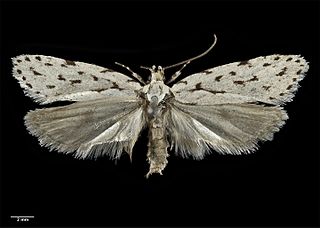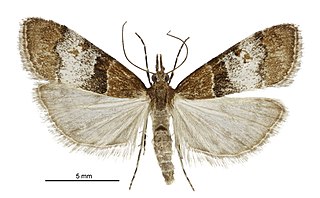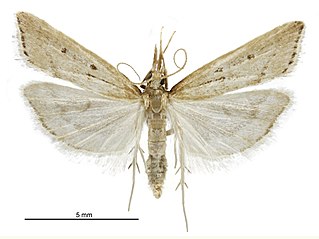
The Aztec thrush is a species of bird in the family Turdidae. It is found mainly in Mexico, but vagrants are occasionally seen in the United States. Its natural habitat is montane forests. The IUCN Red List denotes it as a least-concern species.

Izatha heroica is a moth of the family Oecophoridae. It is endemic to New Zealand, where it is widespread in the west part of the South Island. It has been collected in southern beech forests but larvae have been reared on dead kanuka or manuka bushes.

Amblyptilia epotis is a moth of the family Pterophoridae. It is endemic to New Zealand and is found in the South and Stewart Islands. It inhabits mountainous terrain covered in alpine vegetation or alternatively alpine wetland habitat. The adults of this species are on the wing from February to March. In appearance the adults of this species are variable in colour however this species can be distinguished from similar species by the oblique apical streak on its forewings as well as the patch of white on the costa cilia towards the apex of the forewing.
Australephestiodes is a genus of moths belonging to the family Pyralidae. It contains only one species Australephestiodes stictella, which is found in Florida and on the Bahamas, Jamaica, Puerto Rico and the Virgin Islands.

Antiscopa acompa is a moth in the family Crambidae. It was first described by Edward Meyrick in 1884. It is endemic to New Zealand and is found both the North and South Islands. The species inhabits native forest and adult moths are attracted to light.

Antiscopa elaphra is a moth in the family Crambidae. It is endemic to New Zealand and has been observed in both the North and South Islands. Adults of this species are on the wing from August until March and are attracted to light. In 2020 this species had its DNA barcode sequenced.
Scoparia anadonta is a moth in the family Crambidae. It was described by Harrison Gray Dyar Jr. in 1918. It is found in Hidalgo, Mexico.
Scoparia multifacies is a moth in the family Crambidae. It was described by Harrison Gray Dyar Jr. in 1929. It is found in Guatemala and Xalapa, Mexico.
Cymbopteryx extralinea is a moth in the family Crambidae. It was described by Harrison Gray Dyar Jr. in 1914. It is found in Puebla, Mexico.
Exaeretia hildaella is a moth in the family Depressariidae. It was described by John Frederick Gates Clarke in 1941. It is found in North America, where it has been recorded from Alberta and the Northwest Territories.
Exaeretia thoracefasciella is a moth in the family Depressariidae. It is found in North America, where it has been recorded from California to Washington.
Garrha rufa is a moth in the family Oecophoridae. It was described by Edward Meyrick in 1883. It is found in Australia, where it has been recorded from New South Wales.
Nites maculatella is a moth in the family Depressariidae. It was described by August Busck in 1908. It is found in North America, where it has been recorded from Vermont, Ontario, Pennsylvania, Ohio, Indiana, Kentucky, Maine, Maryland and West Virginia.
Tosca plutonella is a moth of the family Gelechiidae. It was described by Carl Heinrich in 1920. It is found in North America, where it has been recorded from New Mexico.
Taygete sylvicolella is a moth in the family Autostichidae. It was described by August Busck in 1903. It is found in North America, where it has been recorded from Illinois, Maine, New York, Ohio and South Carolina.
Antaeotricha zelleri is a moth in the family Depressariidae. It was described by Lord Walsingham and John Hartley Durrant in 1896. It is found in Panama, Costa Rica, French Guiana and Brazil.
Antaeotricha similis is a moth in the family Depressariidae. It was described by August Busck in 1911. It is found in the Guianas and Brazil.
Gonioterma anna is a moth in the family Depressariidae. It was described by August Busck in 1911. It is found in the Guianas and Brazil.
Podalia amarga is a moth of the family Megalopygidae. It was described by Schaus in 1905.

Tingena horaea is a species of moth in the family Oecophoridae. It is endemic to New Zealand and have been observed in both the North and South Islands. The adults are on the wing in January.





